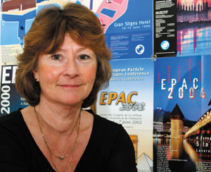The European Particle Accelerator Conference, EPAC, has developed a distinctive role on the world stage, explains Christine Petit-Jean-Genaz, the EPAC conferences coordinator.

When CERN’s Kurt Hübner and Günther Plass travelled to Rome in 1986 to join Sergio Tazzari of the Frascati Laboratory in search of a venue for the first European Particle Accelerator Conference, they set in motion the machinery that was to give the European accelerator community its own conference, 20 years after the birth of the American Particle Accelerator Conference, PAC. Two decades later, with science funding tight and justifiably under close scrutiny, it is interesting to assess the value, and also the spin-off, of this event.
In July EPAC’04 will welcome around 800 delegates from more than 30 countries to the ninth conference in the series. Sixty-five oral presentations are scheduled and more than 1000 posters will be displayed during the lively sessions. Two European accelerator prizes, first introduced in 1994, will also be awarded, one for a recent significant, original contribution to the accelerator field from a scientist in the early part of his or her career, and one for outstanding achievement in the accelerator field. This will precede a regular conference highlight, the “entertainment” session, with a talk on cosmic accelerators. The industrial exhibition and its associated session on technology transfer and industrial contacts completes the picture, demonstrating the vital communication between scientists and representatives of industry. This is a very different conference from the first one in 1988.
EPAC’88, held at the Hotel Parco dei Principi in Rome, was a victim of its own success. When the estimated 400 delegates expanded to 700 there was “controlled chaos” as closed-circuit TV had to relay the oral presentations, authors shared poster boards, a lack of air-conditioning caused delegates to flee the industrial exhibition and a lack of space meant the plenary sessions were relocated to the Aula Magna of the “La Sapienza” University of Rome. Alas, it was too late to relocate the conference dinner. Those who recall the fountains dancing in time to the strains of a string quartet in the gardens of the Villa Tuscolana will also remember the mouth-watering buffet, which was woefully insufficient and had vanished before the guests finished arriving.
However, the learning process had begun, and the venue for EPAC’90 was a purpose-built conference centre in Nice. Only one detail escaped the vigilant local organizing committee: the unique banquet venue able to cater for 800 people was outdoors, on a beautiful, unsheltered, Mediterranean beach. A week of perfect weather was marred only by the cloud that burst that particular evening. Who recalls the drenched delegates arriving following a 200 metre sprint in a tropical downpour?
During this period, Maurice Jacob, chairman of the European Physical Society (EPS), convinced EPAC’s organizers to form an EPS Interdivisional Group on Accelerators (IGA), and the successive EPS-IGA elected boards have since formed the EPAC organizing committees. A biennial, one-third turnover of the 18 members ensures continuity, while encouraging new members to introduce new ideas. To promote communication between the regional conferences, the organizing committees welcome representatives of US and Asian PACs, and the chairmen meet informally each year. The EPS-IGA has undertaken a number of initiatives such as the Student Grant Programme which, with the sponsorship of European laboratories and industry, enables young scientists to attend EPAC; around 60 will attend EPAC’04 under this scheme.
Continuity, coordination and communication characterize EPAC organization. Participation has increased steadily, with almost half the participants coming from non-European countries. Improved management techniques have streamlined the workload and contained registration fees. This was also a result of publishing the proceedings in CD-ROM and Web format, rather than expensive paper-hungry hard-copy volumes.
An unexpected spin-off of regional collaboration has been the creation of the Joint Accelerator Conferences Website (JACoW). The suggestion by Ilan Ben-Zvi of the Brookhaven National Laboratory in the mid-1990s to create a website for the publication of regional accelerator conference proceedings has developed into a flourishing international collaboration. It now extends to a whole range of conference series on accelerators – CYCLOTRONS, DIPAC, ICALEPCS, LINAC and RUPAC. The editors of all eight series, led by CERN’s John Poole, get hands-on experience in electronic publication techniques during each PAC and EPAC. Furthermore, the yearly team meetings have led to the development of a Scientific Programme Management System. This is an Oracle-based application capable of handling conference contributions from abstract submission through to proceedings production. Twenty-three sets have been published since 1996, including scanned PAC proceedings dating back to 1967. The EPAC and LINAC series plan to follow suit and scan their pre-electronic era proceedings too.
EPAC has evolved into an established, respected forum for the state of the art in accelerator technology. Delegates meet at unique venues, where the varied cultural heritage constitutes real added value. Strengthened ties with other regional and specialized conferences have enhanced international collaboration in the accelerator field, to the undoubted benefit of the community worldwide.
Further reading
For more about JACoW, see www.jacow.org.





